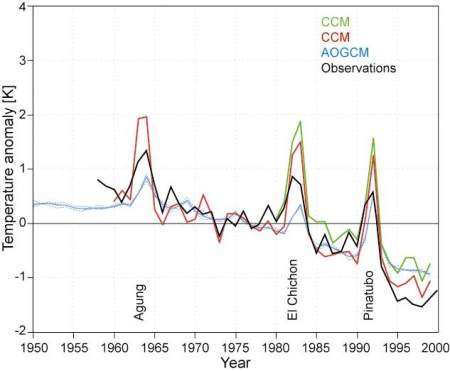 Web Content Display Web Content Display
PHASE III: Climate impacts of major volcanic eruptions on the atmosphere and ocean
To investigate the influence of major volcanic eruptions on the atmosphere and ocean, two different climate models have been employed. One model is the coupled atmosphere ocean general circulation model (AOGCM) ECHAM5-MPIOM with a model top at 30 km altitude in the atmosphere (Jungclaus et al., 2006). The second model is the coupled chemistry climate model (CCM) MAECHAM4CHEM with an upper model lid at 80 km altitude (Steil et al., 2003) used also for the WMO ozone assessment (2003). In each case, the volcanic eruptions of Mt. Agung 1963, El Chichón 1982, and Mt. Pinatubo 1991 were considered. Both models show the observed warming of the lower stratosphere (50 hPa, ~20 km altitude) in the global annual mean temperature during the first two years following each of the major volcanic eruptions (Fig. 8). The warming is due to the absorption of incoming solar radiation and outgoing terrestrial radiation by the volcanic aerosol particles in the stratosphere. Due to the differently parameterized volcanic forcings, the strength of the atmospheric response between the two model versions varies substantially, being too weak in the AOGCM and too strong in the CCM compared to observations (Fig. 8). In the troposphere a global cooling is observed in response to radiation absorbed by the volcanic stratospheric aerosols. Therefore volcanic eruptions can mask or even delay the anthropogenically induced global warming (IPCC, 2007).
Fig 8: Global temperature anomalies in the lower stratosphere (at 50 hPa approximately 20 km altitude) following the Mt. Agung 1963, El Chichón 1982, and Mt. Pinatubo 1991 volcanic eruptions. Results from three AOGCM (blue lines) and two CCM (green and red lines) simulations (Krüger K. and C. Timmreck, personal communication 2007). References: IPCC Climate Change (2007) The Physical Science Basis. Contribution of Working Group I to the Fourth Assessment Report of the Intergovernmental Panel on Climate Change. Solomon, S, Qin D, Manning M, Chen Z, Marquis M, Averyt K B, Tignor M and Miller H L (eds.). Cambridge University Press, Cambridge, United Kingdom and New York, NY, USA, 996 pp Jungclaus, J H, Keenlyside N, Botzet M, Haak H, Luo J-J, Latif M, Marotzke J, Mikolajewicz U, Roeckner E (2006) Ocean circulation and tropical variability in the coupled model ECHAM5/MPI-OM. J Climate 19: 3952-3972 Steil, B, C Brühl, E Manzini, PJ Crutzen, J Lelieveld, PJ Rasch, E Roeckner, and K Krüger (2003) A new interactive chemistry climate model. I: Present day climatology and interannual variability of the middle atmosphere using the model and 9 years of HALOE/UARS data. J. Geophys. Res., 108(D9), 4290, doi:10.1029/2002JD002971 WMO (World Meteorological Organization) (2003), Scientific Assessment of Ozone Depletion: 2002, Global Ozone Research and Monitoring Project-Report No. 47, 498 pp., Geneva |
 Events Events
Kieler Wissenschaftler fühlen den 'Puls der Erde' Wie funktioniert die Recyclingmaschine der Erde?Nach elf Jahren endet der Kieler Sonderforschungsbereich 574 zu Subduktionszonen Final colloquium of SFB 574 Teilprojekt ÖffentlichkeitsarbeitMEERESFORSCHUNG FÜR MICH UND DICH |
|
©SFB574 // Wischhofstrasse 1-3 // D-24148 Kiel // T. +49 (0)431 600 1413 // elange [AT] geomar.de






